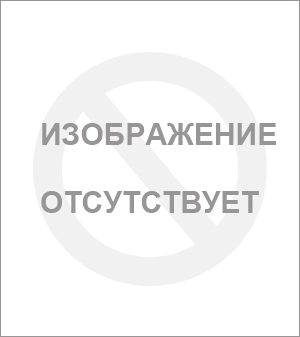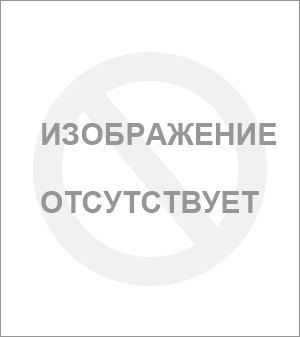-
Contents
-
Table of Contents
-
Troubleshooting
-
Bookmarks
Quick Links
NE 1/ 3926 GB
RENAULT PREMIUM
DXi 11
330 — 380 — 440
50 21 022 931 — 06/2005
english edition
Contents
Chapter
Foreword. . . . . . . . . . . . . . . . . . . . . . . . . . . . . . . . .A
Presentation . . . . . . . . . . . . . . . . . . . . . . . . . . . . .B
Vehicle Access And Protection. . . . . . . . . . . . . . . . . . . . . . . . . . . . . . . . . . . . . . . . . . . . . . . . . . . . . . . . . . . . . . . . . . . . . . . . . . . . . . . . . . . . . . . . . . . . . . . . . . . . . . . . . . . . . . . . . . . . . . . . . . . . . . . . . . . . . . . . . . . . . . . . . . . . . . . . . . . . . . . . . . . . . . . . . . . B1
Driving Position. . . . . . . . . . . . . . . . . . . . . . . . . . . . . . . . . . . . . . . . . . . . . . . . . . . . . . . . . . . . . . . . . . . . . . . . . . . . . . . . . . . . . . . . . . . . . . . . . . . . . . . . . . . . . . . . . . . . . . . . . . . . . . . . . . . . . . . . . . . . . . . . . . . . . . . . . . . . . . . . . . . . . . . . . . . . . . . . . . . . . . B2
Safety . . . . . . . . . . . . . . . . . . . . . . . . . . . . . . . . . . . . . . . . . . . . . . . . . . . . . . . . . . . . . . . . . . . . . . . . . . . . . . . . . . . . . . . . . . . . . . . . . . . . . . . . . . . . . . . . . . . . . . . . . . . . . . . . . . . . . . . . . . . . . . . . . . . . . . . . . . . . . . . . . . . . . . . . . . . . . . . . . . . . . . . . . . . . . . B3
Driving . . . . . . . . . . . . . . . . . . . . . . . . . . . . . . . . . . . .C
Special Conditions . . . . . . . . . . . . . . . . . . . . . . . . . . . . . . . . . . . . . . . . . . . . . . . . . . . . . . . . . . . . . . . . . . . . . . . . . . . . . . . . . . . . . . . . . . . . . . . . . . . . . . . . . . . . . . . . . . . . . . . . . . . . . . . . . . . . . . . . . . . . . . . . . . . . . . . . . . . . . . . . . . . . . . . . . . . . . . . . . . . . C1
Prior To Starting. . . . . . . . . . . . . . . . . . . . . . . . . . . . . . . . . . . . . . . . . . . . . . . . . . . . . . . . . . . . . . . . . . . . . . . . . . . . . . . . . . . . . . . . . . . . . . . . . . . . . . . . . . . . . . . . . . . . . . . . . . . . . . . . . . . . . . . . . . . . . . . . . . . . . . . . . . . . . . . . . . . . . . . . . . . . . . . . . . . . . . C2
Start-Up . . . . . . . . . . . . . . . . . . . . . . . . . . . . . . . . . . . . . . . . . . . . . . . . . . . . . . . . . . . . . . . . . . . . . . . . . . . . . . . . . . . . . . . . . . . . . . . . . . . . . . . . . . . . . . . . . . . . . . . . . . . . . . . . . . . . . . . . . . . . . . . . . . . . . . . . . . . . . . . . . . . . . . . . . . . . . . . . . . . . . . . . . . . . C3
On The Road . . . . . . . . . . . . . . . . . . . . . . . . . . . . . . . . . . . . . . . . . . . . . . . . . . . . . . . . . . . . . . . . . . . . . . . . . . . . . . . . . . . . . . . . . . . . . . . . . . . . . . . . . . . . . . . . . . . . . . . . . . . . . . . . . . . . . . . . . . . . . . . . . . . . . . . . . . . . . . . . . . . . . . . . . . . . . . . . . . . . . . . . . C4
Stopping . . . . . . . . . . . . . . . . . . . . . . . . . . . . . . . . . . . . . . . . . . . . . . . . . . . . . . . . . . . . . . . . . . . . . . . . . . . . . . . . . . . . . . . . . . . . . . . . . . . . . . . . . . . . . . . . . . . . . . . . . . . . . . . . . . . . . . . . . . . . . . . . . . . . . . . . . . . . . . . . . . . . . . . . . . . . . . . . . . . . . . . . . . . . C5
Driving On Difficult Terrain . . . . . . . . . . . . . . . . . . . . . . . . . . . . . . . . . . . . . . . . . . . . . . . . . . . . . . . . . . . . . . . . . . . . . . . . . . . . . . . . . . . . . . . . . . . . . . . . . . . . . . . . . . . . . . . . . . . . . . . . . . . . . . . . . . . . . . . . . . . . . . . . . . . . . . . . . . . . . . . . . . . . . . . . . . . . C6
Trade Equipment . . . . . . . . . . . . . . . . . . . . . . . . . . . . . . . . . . . . . . . . . . . . . . . . . . . . . . . . . . . . . . . . . . . . . . . . . . . . . . . . . . . . . . . . . . . . . . . . . . . . . . . . . . . . . . . . . . . . . . . . . . . . . . . . . . . . . . . . . . . . . . . . . . . . . . . . . . . . . . . . . . . . . . . . . . . . . . . . . . . . . D1
Monitoring / Management Equipment . . . . . . . . . . . . . . . . . . . . . . . . . . . . . . . . . . . . . . . . . . . . . . . . . . . . . . . . . . . . . . . . . . . . . . . . . . . . . . . . . . . . . . . . . . . . . . . . . . . . . . . . . . . . . . . . . . . . . . . . . . . . . . . . . . . . . . . . . . . . . . . . . . . . . . . . . . . . . . . . . . . D2
Identification . . . . . . . . . . . . . . . . . . . . . . . . . . . . . . . . . . . . . . . . . . . . . . . . . . . . . . . . . . . . . . . . . . . . . . . . . . . . . . . . . . . . . . . . . . . . . . . . . . . . . . . . . . . . . . . . . . . . . . . . . . . . . . . . . . . . . . . . . . . . . . . . . . . . . . . . . . . . . . . . . . . . . . . . . . . . . . . . . . . . . . . . E1
Daily Checks. . . . . . . . . . . . . . . . . . . . . . . . . . . . . . . . . . . . . . . . . . . . . . . . . . . . . . . . . . . . . . . . . . . . . . . . . . . . . . . . . . . . . . . . . . . . . . . . . . . . . . . . . . . . . . . . . . . . . . . . . . . . . . . . . . . . . . . . . . . . . . . . . . . . . . . . . . . . . . . . . . . . . . . . . . . . . . . . . . . . . . . . . E2
Routine servicing . . . . . . . . . . . . . . . . . . . . . . . . . . . . . . . . . . . . . . . . . . . . . . . . . . . . . . . . . . . . . . . . . . . . . . . . . . . . . . . . . . . . . . . . . . . . . . . . . . . . . . . . . . . . . . . . . . . . . . . . . . . . . . . . . . . . . . . . . . . . . . . . . . . . . . . . . . . . . . . . . . . . . . . . . . . . . . . . . . . . E3
Maintenance Instructions . . . . . . . . . . . . . . . . . . . . . . . . . . . . . . . . . . . . . . . . . . . . . . . . . . . . . . . . . . . . . . . . . . . . . . . . . . . . . . . . . . . . . . . . . . . . . . . . . . . . . . . . . . . . . . . . . . . . . . . . . . . . . . . . . . . . . . . . . . . . . . . . . . . . . . . . . . . . . . . . . . . . . . . . . . . . . . E4
Servicing Intervals . . . . . . . . . . . . . . . . . . . . . . . . . . . . . . . . . . . . . . . . . . . . . . . . . . . . . . . . . . . . . . . . . . . . . . . . . . . . . . . . . . . . . . . . . . . . . . . . . . . . . . . . . . . . . . . . . . . . . . . . . . . . . . . . . . . . . . . . . . . . . . . . . . . . . . . . . . . . . . . . . . . . . . . . . . . . . . . . . . . E5
Engine . . . . . . . . . . . . . . . . . . . . . . . . . . . . . . . . . . . . . . . . . . . . . . . . . . . . . . . . . . . . . . . . . . . . . . . . . . . . . . . . . . . . . . . . . . . . . . . . . . . . . . . . . . . . . . . . . . . . . . . . . . . . . . . . . . . . . . . . . . . . . . . . . . . . . . . . . . . . . . . . . . . . . . . . . . . . . . . . . . . . . . . . . . . . . E6
Engine cooling . . . . . . . . . . . . . . . . . . . . . . . . . . . . . . . . . . . . . . . . . . . . . . . . . . . . . . . . . . . . . . . . . . . . . . . . . . . . . . . . . . . . . . . . . . . . . . . . . . . . . . . . . . . . . . . . . . . . . . . . . . . . . . . . . . . . . . . . . . . . . . . . . . . . . . . . . . . . . . . . . . . . . . . . . . . . . . . . . . . . . . . E7
Fuel system . . . . . . . . . . . . . . . . . . . . . . . . . . . . . . . . . . . . . . . . . . . . . . . . . . . . . . . . . . . . . . . . . . . . . . . . . . . . . . . . . . . . . . . . . . . . . . . . . . . . . . . . . . . . . . . . . . . . . . . . . . . . . . . . . . . . . . . . . . . . . . . . . . . . . . . . . . . . . . . . . . . . . . . . . . . . . . . . . . . . . . . . . E8
Clutch. . . . . . . . . . . . . . . . . . . . . . . . . . . . . . . . . . . . . . . . . . . . . . . . . . . . . . . . . . . . . . . . . . . . . . . . . . . . . . . . . . . . . . . . . . . . . . . . . . . . . . . . . . . . . . . . . . . . . . . . . . . . . . . . . . . . . . . . . . . . . . . . . . . . . . . . . . . . . . . . . . . . . . . . . . . . . . . . . . . . . . . . . . . . . . E9
Gearbox . . . . . . . . . . . . . . . . . . . . . . . . . . . . . . . . . . . . . . . . . . . . . . . . . . . . . . . . . . . . . . . . . . . . . . . . . . . . . . . . . . . . . . . . . . . . . . . . . . . . . . . . . . . . . . . . . . . . . . . . . . . . . . . . . . . . . . . . . . . . . . . . . . . . . . . . . . . . . . . . . . . . . . . . . . . . . . . . . . . . . . . . . . . E10
Hydraulic Retarder . . . . . . . . . . . . . . . . . . . . . . . . . . . . . . . . . . . . . . . . . . . . . . . . . . . . . . . . . . . . . . . . . . . . . . . . . . . . . . . . . . . . . . . . . . . . . . . . . . . . . . . . . . . . . . . . . . . . . . . . . . . . . . . . . . . . . . . . . . . . . . . . . . . . . . . . . . . . . . . . . . . . . . . . . . . . . . . . . . E11
Power Take-Off . . . . . . . . . . . . . . . . . . . . . . . . . . . . . . . . . . . . . . . . . . . . . . . . . . . . . . . . . . . . . . . . . . . . . . . . . . . . . . . . . . . . . . . . . . . . . . . . . . . . . . . . . . . . . . . . . . . . . . . . . . . . . . . . . . . . . . . . . . . . . . . . . . . . . . . . . . . . . . . . . . . . . . . . . . . . . . . . . . . . . . E12
Prop shaft. . . . . . . . . . . . . . . . . . . . . . . . . . . . . . . . . . . . . . . . . . . . . . . . . . . . . . . . . . . . . . . . . . . . . . . . . . . . . . . . . . . . . . . . . . . . . . . . . . . . . . . . . . . . . . . . . . . . . . . . . . . . . . . . . . . . . . . . . . . . . . . . . . . . . . . . . . . . . . . . . . . . . . . . . . . . . . . . . . . . . . . . . . E13
Axle. . . . . . . . . . . . . . . . . . . . . . . . . . . . . . . . . . . . . . . . . . . . . . . . . . . . . . . . . . . . . . . . . . . . . . . . . . . . . . . . . . . . . . . . . . . . . . . . . . . . . . . . . . . . . . . . . . . . . . . . . . . . . . . . . . . . . . . . . . . . . . . . . . . . . . . . . . . . . . . . . . . . . . . . . . . . . . . . . . . . . . . . . . . . . . . E14
Rear drive axle . . . . . . . . . . . . . . . . . . . . . . . . . . . . . . . . . . . . . . . . . . . . . . . . . . . . . . . . . . . . . . . . . . . . . . . . . . . . . . . . . . . . . . . . . . . . . . . . . . . . . . . . . . . . . . . . . . . . . . . . . . . . . . . . . . . . . . . . . . . . . . . . . . . . . . . . . . . . . . . . . . . . . . . . . . . . . . . . . . . . . E15
Suspension systems . . . . . . . . . . . . . . . . . . . . . . . . . . . . . . . . . . . . . . . . . . . . . . . . . . . . . . . . . . . . . . . . . . . . . . . . . . . . . . . . . . . . . . . . . . . . . . . . . . . . . . . . . . . . . . . . . . . . . . . . . . . . . . . . . . . . . . . . . . . . . . . . . . . . . . . . . . . . . . . . . . . . . . . . . . . . . . . . . . E16
Steering . . . . . . . . . . . . . . . . . . . . . . . . . . . . . . . . . . . . . . . . . . . . . . . . . . . . . . . . . . . . . . . . . . . . . . . . . . . . . . . . . . . . . . . . . . . . . . . . . . . . . . . . . . . . . . . . . . . . . . . . . . . . . . . . . . . . . . . . . . . . . . . . . . . . . . . . . . . . . . . . . . . . . . . . . . . . . . . . . . . . . . . . . . . E17
Cab Tilting . . . . . . . . . . . . . . . . . . . . . . . . . . . . . . . . . . . . . . . . . . . . . . . . . . . . . . . . . . . . . . . . . . . . . . . . . . . . . . . . . . . . . . . . . . . . . . . . . . . . . . . . . . . . . . . . . . . . . . . . . . . . . . . . . . . . . . . . . . . . . . . . . . . . . . . . . . . . . . . . . . . . . . . . . . . . . . . . . . . . . . . . . E18
Brakes . . . . . . . . . . . . . . . . . . . . . . . . . . . . . . . . . . . . . . . . . . . . . . . . . . . . . . . . . . . . . . . . . . . . . . . . . . . . . . . . . . . . . . . . . . . . . . . . . . . . . . . . . . . . . . . . . . . . . . . . . . . . . . . . . . . . . . . . . . . . . . . . . . . . . . . . . . . . . . . . . . . . . . . . . . . . . . . . . . . . . . . . . . . . E19
Roadwheels / Tyres . . . . . . . . . . . . . . . . . . . . . . . . . . . . . . . . . . . . . . . . . . . . . . . . . . . . . . . . . . . . . . . . . . . . . . . . . . . . . . . . . . . . . . . . . . . . . . . . . . . . . . . . . . . . . . . . . . . . . . . . . . . . . . . . . . . . . . . . . . . . . . . . . . . . . . . . . . . . . . . . . . . . . . . . . . . . . . . . . . E20
Heating / Air Conditioning . . . . . . . . . . . . . . . . . . . . . . . . . . . . . . . . . . . . . . . . . . . . . . . . . . . . . . . . . . . . . . . . . . . . . . . . . . . . . . . . . . . . . . . . . . . . . . . . . . . . . . . . . . . . . . . . . . . . . . . . . . . . . . . . . . . . . . . . . . . . . . . . . . . . . . . . . . . . . . . . . . . . . . . . . . . . E21
Independent Heating . . . . . . . . . . . . . . . . . . . . . . . . . . . . . . . . . . . . . . . . . . . . . . . . . . . . . . . . . . . . . . . . . . . . . . . . . . . . . . . . . . . . . . . . . . . . . . . . . . . . . . . . . . . . . . . . . . . . . . . . . . . . . . . . . . . . . . . . . . . . . . . . . . . . . . . . . . . . . . . . . . . . . . . . . . . . . . . . . E22
Batteries . . . . . . . . . . . . . . . . . . . . . . . . . . . . . . . . . . . . . . . . . . . . . . . . . . . . . . . . . . . . . . . . . . . . . . . . . . . . . . . . . . . . . . . . . . . . . . . . . . . . . . . . . . . . . . . . . . . . . . . . . . . . . . . . . . . . . . . . . . . . . . . . . . . . . . . . . . . . . . . . . . . . . . . . . . . . . . . . . . . . . . . . . . . E23
Alternator . . . . . . . . . . . . . . . . . . . . . . . . . . . . . . . . . . . . . . . . . . . . . . . . . . . . . . . . . . . . . . . . . . . . . . . . . . . . . . . . . . . . . . . . . . . . . . . . . . . . . . . . . . . . . . . . . . . . . . . . . . . . . . . . . . . . . . . . . . . . . . . . . . . . . . . . . . . . . . . . . . . . . . . . . . . . . . . . . . . . . . . . . E24
Starter . . . . . . . . . . . . . . . . . . . . . . . . . . . . . . . . . . . . . . . . . . . . . . . . . . . . . . . . . . . . . . . . . . . . . . . . . . . . . . . . . . . . . . . . . . . . . . . . . . . . . . . . . . . . . . . . . . . . . . . . . . . . . . . . . . . . . . . . . . . . . . . . . . . . . . . . . . . . . . . . . . . . . . . . . . . . . . . . . . . . . . . . . . . . E25
Compressed Air System . . . . . . . . . . . . . . . . . . . . . . . . . . . . . . . . . . . . . . . . . . . . . . . . . . . . . . . . . . . . . . . . . . . . . . . . . . . . . . . . . . . . . . . . . . . . . . . . . . . . . . . . . . . . . . . . . . . . . . . . . . . . . . . . . . . . . . . . . . . . . . . . . . . . . . . . . . . . . . . . . . . . . . . . . . . . . . . E26
Fifth Wheel Coupling . . . . . . . . . . . . . . . . . . . . . . . . . . . . . . . . . . . . . . . . . . . . . . . . . . . . . . . . . . . . . . . . . . . . . . . . . . . . . . . . . . . . . . . . . . . . . . . . . . . . . . . . . . . . . . . . . . . . . . . . . . . . . . . . . . . . . . . . . . . . . . . . . . . . . . . . . . . . . . . . . . . . . . . . . . . . . . . . . E27
Cleaning . . . . . . . . . . . . . . . . . . . . . . . . . . . . . . . . . . . . . . . . . . . . . . . . . . . . . . . . . . . . . . . . . . . . . . . . . . . . . . . . . . . . . . . . . . . . . . . . . . . . . . . . . . . . . . . . . . . . . . . . . . . . . . . . . . . . . . . . . . . . . . . . . . . . . . . . . . . . . . . . . . . . . . . . . . . . . . . . . . . . . . . . . . . E28
RENAULT TRUCKS
Société Anonyme au capital de 50 000 000 €
Siège social : 99, route de Lyon
69802 Saint-Priest
Siret 954 506 077 00 120 — RCS LYON B 954 506 077
Summary of Contents for Renault Premium DXi 11

Руководство по эксплуатации и техническому обслуживанию автомобилей Renault Premium DXi 11 330/370/380/410/440/450.
- Автор: —
- Издательство: Диез
- Год издания: —
- Страниц: 256
- Формат: —
- Размер: —

Руководство по эксплуатации и техническому обслуживанию автомобилей Renault Premium.
- Автор: —
- Издательство: Motorist
- Год издания: —
- Страниц: 285
- Формат: —
- Размер: —

Руководство по ремонту автомобиля Renault Premium dCi.
- Автор: —
- Издательство: Терция
- Год издания: —
- Страниц: 184
- Формат: —
- Размер: —
Сборник руководств на английском языке по ремонту автомобиля Renault Premium.
- Автор: —
- Издательство: —
- Год издания: —
- Страниц: —
- Формат: PDF
- Размер: 13,2 Mb

Руководство по эксплуатации и техническому обслуживанию автомобиля Renault Premium.
- Автор: —
- Издательство: Renault
- Год издания: 2007
- Страниц: 156
- Формат: PDF
- Размер: 54,9 Mb

Руководство по эксплуатации, техническому обслуживанию и ремонту автомобилей Renault Kerax 1996-2013 и Renault Premium 1996-2006 годов выпуска.
- Автор: —
- Издательство: Арус
- Год издания: —
- Страниц: 792
- Формат: —
- Размер: —

Руководство по эксплуатации и техническому обслуживанию автомобиля Renault Premium dCi.
- Автор: —
- Издательство: Терция
- Год издания: —
- Страниц: 180
- Формат: —
- Размер: —

Руководство по эксплуатации и ремонту автомобиля Renault Premium.
- Автор: —
- Издательство: Терция
- Год издания: —
- Страниц: 270
- Формат: —
- Размер: —

Руководство по ремонту электрооборудования автомобиля Renault Premium.
- Автор: —
- Издательство: Renault
- Год издания: 1997
- Страниц: 265
- Формат: DjVu
- Размер: 106,3 Mb

RENAULT TRUCKS
NE 1/ 3926 GB
RENAULT PREMIUM
DXi 11 330 — 380 — 440
50 21 022 931 — 06/2005 english edition
Contents
Chapter
FOREWORD. . . . . . . . . . . . . . . . . . . . . . . . . . . . . . . . .A PRESENTATION . . . . . . . . . . . . . . . . . . . . . . . . . . . . .B DRIVING . . . . . . . . . . . . . . . . . . . . . . . . . . . . . . . . . . . .C USE OF THE EQUIPMENT . . . . . . . . . . . . . . . . . . . .D FEATURES — SERVICING . . . . . . . . . . . . . . . . . . . . .E QUICK BREAKDOWN REPAIR. . . . . . . . . . . . . . . .F BODYBUILDER INFORMATION . . . . . . . . . . . . . .G
Société Anonyme au capital de 50 000 000 € Siège social : 99, route de Lyon
69802 Saint-Priest
Siret 954 506 077 00 120 — RCS LYON B 954 506 077
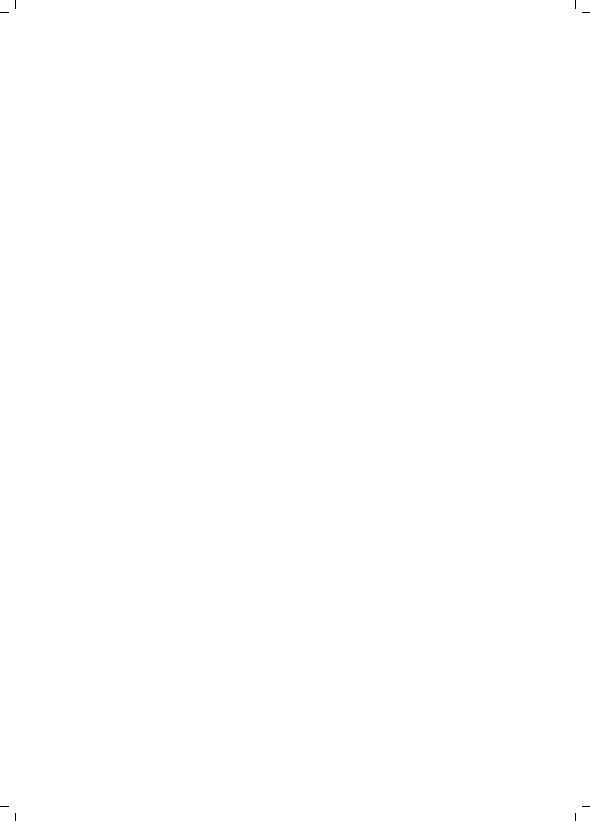
The manufacturer reserves the right to make any modifications deemed necessary during production. This handbook should not be considered as a specification for the model in question.
© RENAULT TRUCKS SA — 2004 — Imprimé en France

Alphabetical index
A
Accelerator pedal, C4-6
ADR vehicle (transport of dangerous materials), B3-4, C5-3
Adjusting the steering wheel, B2-50 Advice, E20-6
Air filters, E6-6
Air tanks, E2-3, E26-2 Air vents, B2-60 Alarm, B1-9
Anti-slip regulator (ASR), C6-2
APM (Air Production Management) unit, E26-1
Axle, steering maintenance operations, E5-9
B
Beam height correction, E3-9 Bleeding the fuel system, E8-5 Bodywork, G-1
Brakes maintenance operations, E5-10 Brakes types, E19-1
Brake pads, E19-2 Brake valve, E26-1
«EBS» braking system, C4-42 Bulbs, E3-1
Bunks and storage compartments, B2-69
C
Cab overhead lights, B2-74
Cab tilting system oil capacity, E18-1 Cab tilting, B1-20, E18-1
Chassis, cab, electrics maintenance operations, E5-11
Checking the oil level, E2-2, E6-3 Child safety, B3-2
Circuit capacity, E9-1 Cleaning the cockpit, E28-2
Cleaning the fascia panel, E28-2 Cleaning the headlamps, E28-2 Cleaning the seats, E28-2 Clutch fluid level, E2-1
Clutch system, E9-2 Clutch types, E9-1
Clutch, gearbox, power take-off maintenance operations, E5-8 Combined lights and horn switch, B2-47 Coolant level, E2-1
Coolant, E7-1 Cruise control, C4-3
D
Daily checks, E2-1 Dashboard, B2-6
Description of Optidriver 2, C4-29 Diagnostic socket, D2-1
Display test, C2-5 Doors, B1-2
Drive axle P 1395 A oil change, E15-2 Drive axle P13170 oil change, E15-1 Drive axle, prop shaft maintenance operations, E5-9
«Rear drive axle(s)» diff. lock, C6-1 Driving a solo tractor, C1-3 Driving Monitoring System, C4-20 Driving on difficult terrain, C6-1 DXi 11, E6-2
E
Economic driving, C1-3
Electrically operated rearview mirrors, B2-46
Electrically operated sun-roof, B2-53 Electric window raiser controls, B2-52 Electronic air suspension, D1-9 Electronic speed limiter, C4-6 Emergency brake, C4-49
Engine idling speed adjustment device, C3-5
Engine immobilizer, C2-4
Engine maintenance operations, E5-6 Engine oil capacities, E6-2
Engine oil level gauge, C2-2 Engine operating speed, C4-2 Engine starting with pilot-controlled starter feature, C3-3
«ESP» (electronic stability program) system, C4-47

Alphabetical index
Exhaust brake and exhaust brake «OPTIBRAKE» (with Optidriver 2 gearbox), C4-12
Exhaust brake with engine brake «OPTIBRAKE» (with manual gearbox), C4-10
Exhaust brake with engine brake «OPTIBRAKE» coupled with a VOITH hydraulic retarder (with Optidriver 2 gearbox), C4-14
Exhaust brake with or without engine brake «OPTIBRAKE» coupled with a ZF hydraulic retarder (with ZF gearbox), C4-18
Exhaust brake (with manual gearbox), C4-9
External storage locker(s), B1-23
F
Fall-back mode (lever disconnected), C4-40
Fan-coil heater filter, E21-2 Fast idling device, C3-6 Fault display, C2-6
Fifth wheel coupling, D1-2 «FONTAINE» sliding fifth wheel coupling, D1-8
«GEORG FISCHER» fifth wheel coupling, D1-4
«JOST» fifth wheel coupling, D1-5 «JOST» 42 fifth wheel coupling, D1-6 Fifth wheel types, E27-1
Filling the engine cooling system, E7-6 Filter cartridge replacement, E17-1 Fire extinguisher, B3-3
First aid kit, B3-8 Front axle types, E14-1 Front axle, E14-1 Front grille, B1-17
Front suspension, E16-1 Fuel filter(s), E8-3 Fuel preheater, E8-8
Fuel tank capacities, E8-1 Fuel tank(s), B1-25, E8-6 Fuel, E4-3
Fuses, E3-10
G
Gearbox oil capacity, E10-2 Gearbox types, E10-1
ZF gearbox + Intarder oil change, E10-9 General usage instructions for commercial vehicles, A-2
H
Headlamps wash reservoir, E2-5 Headlights adjustment, B2-49, E3-8 Heated windscreen, B2-46
Heating — Ventilation, B2-54 Heating, air conditioning maintenance operations, E5-12
Hydraulic power-assisted steering, C4-1, E17-3
I
Ignition switch, C2-5
Independent heating, B2-61
Infomax, D2-1
Inspection / lubrication, E27-1
Instrument panel, B2-10
International standards, E4-7
K
Keys, B1-1
Key to switches, B2-24
Key to warning pictograms, B2-16 Key to «gearbox» warning pictograms, B2-21
Key to «tachograph» warning pictograms, B2-22
L
Location of jack and onboard kit, F-2 Lubricants, E4-4
Lubrication diagram(s), E4-12
M
Maintenance display, C2-7
Maintenance, E16-1, E21-1
Master switch, B1-26

Alphabetical index
«ADR» master switch (transport of dangerous materials), B1-27 Monitoring / management equipment, D2-1
Multi-function information display, B2-28
O
Oil capacity, E15-1
Oil change, E6-4, E10-8 Oil filters, E6-4 Onboard radio, B2-74
Optidriver 2 gearbox oil change, E10-3 Optidriver 2 gearbox, C4-26, E4-7, E4-9
P
Parking brake, B2-51, C4-50 Power take-off types, E12-1
Power take-off, D1-20, D1-21, E4-9 Precautions, E19-1
Preheating the engine cooling system, C1-4
Prior to getting into the vehicle, C2-1 Protecting diesel fuel against freezing and additives, E8-7
R
Radiator mosquito net, E7-2 Rational use of batteries, E23-6 Rear drive axle types, E15-1 Rear suspension, D1-9, E16-1 Refrigerator, B2-71 Regulatory test display, C2-5 Remote control battery, E3-18 Remote control box, D1-10 Retarder types, E11-1 Retarder, C4-7
VOITH retarder oil change, E10-6 Reversing buzzer, C4-41
Roof air vent, B2-53 Roof deflector, D1-25 Routine servicing, E3-1
S
Seats, B2-1
Seat belts, B3-1
Servicing frequencies, E5-1 Servicing, E22-1
Side fairings, B1-18
Soundproofing screens and heat shields, E6-1
Spare wheel carrier, F-4 Starter types, E25-1 Starting the engine, C3-1
Starting the vehicle using an external power source, F-1
Steering types, E17-1 Stopping the engine, C5-1
Suspension maintenance operations, E5-10
T
Test procedure, D1-19
Tightening the wheel nuts, E20-2, F-7 Towing, F-8
Trade equipment, D1-1 Trailer brake, C4-49 Turbocharger, E6-8 Tyres, E2-4
Tyre features, E20-1 Tyre pressures, E20-3
U
Use at high altitude, C1-2
Use during the summer or in hot climates, C1-2
Use during the winter or in cold climates, C1-1
Use in dusty atmospheres, C1-2 Use of the equipment, D1-1 Use on downhill runs, C4-37 Using the jack, F-5
V
Variable-drive cooling fan, E7-3 Vehicle identification, E1-1 4×2 vehicle with adjustable rear suspension, D1-11
4×2 — 6×2 vehicle with adjustable rear suspension, D1-13

Alphabetical index
4×2 — 6×2 vehicle with integral suspension, D1-17
W
Warranty, E4-1 Washing the body, E28-1
Washing the vehicle, E28-1
Welcome onboard your new RENAULT, A-1
Welding on vehicle, G-1
Wheels, tyres maintenance operations, E5-12
Wheel chocks, B3-3
Windscreen wash reservoir level, E2-4 Windscreen wiper, windscreen wash and headlamps wash control, B2-49 Working spotlight (tractor), D1-1

A-1 Foreword
Welcome onboard your new RENAULT
You have now taken possession of your new vehicle.
We trust that it will give you the entire satisfaction you have the right to expect and which was the reason for your original choice.
This driving and servicing handbook has been laid out to provide all the information you need and will enable you to:
–Get to know your Renault better and, on the same occasion, to derive the maximum of benefit from all the technical perfections with which it is endowed, under the very best working conditions.
–Permanently guarantee optimum operation by simply — but strictly — observing maintenance recommendations.
–Cope with any minor malfunctions not requiring assistance from a specialist, without losing too much time.
This handbook covers all the options proposed to customers.
Take into account only indications corresponding to the model in your possession.
The few moments devoted to reading this handbook will be well worthwhile on account of the information it contains and the new technical features you will discover. If any details remain unclear, our dealer staff will be pleased to provide you with any further information you may require.
To read the text:
The reference numbers, figures and letters mentioned in the text refer back to two types of illustration:
–Figures correspond to figures or photographs situated in proximity to the text.
–Letters, sometimes followed by a figure, correspond to the instrument panel diagram to be found inside the handbook.
«Bon voyage» at the wheel of your Renault !
RENAULT TRUCKS: Frontier-free service
Renault Trucks 24/24 has been in operation for several years now. 19 emergency call centres are listening in for you 365 days a year .
Spare parts officially approved by RENAULT TRUCKS meet both the requirements of the vehicle specification and the regulations in force. Only premium Renault parts will ensure:
–Original Equipment safety standards,
–Full Manufacturer’s Warranty,
–Maintenance of original characteristics and performance.
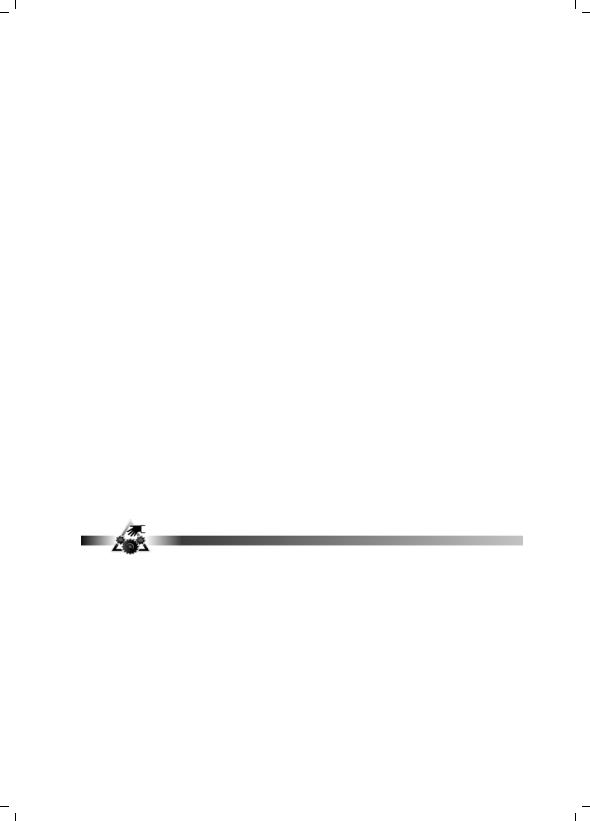
A-2 Foreword
General usage instructions for commercial vehicles
If you are a professional driver using your own vehicle, or a haulier entrusting one of your vehicles to a member of your staff, it is essential to follow and ensure the application of the following instructions. They are only a reminder of the basics of the trade and standard professional practice and in no way are to be taken as exhaustive. In this way you will obtain the maximum profit from your material and prevent any risk of accidents and incidents.
1.A few basic instructions
–Every driver must possess all necessary licences and should only drive when physically fit and sufficiently rested.
–The vehicle must be in conformity with current legislation in the country or countries in which it is used.
–Any signs indicating hazardous substances must be affixed and be in good condition.
–Loads:
•All-up or per-axle weights (regulatory or technical) must not be exceeded.
•Loading and securing of loads must be carried out using conventional procedures, tarpaulins and side curtains must be correctly stretched and fastened and doors and sideboards locked, etc…
–In the cab:
•Never carry dangerous products (such as petroleum, trichlorethylene, thinner, etc.).
•If an animal is carried, it must be kept away from the driving position.
–Getting in and out of the vehicle:
•Use the steps and the handles provided. Never jump down from the vehicle. When leaving the vehicle, observe the traffic flow, particularly if you have been driving for a long time.
•Take extra care when the climatic conditions are bad (rain, snow, ice) and at night.
–USE IN CLOSED PREMISES:
•NEVER LEAVE THE ENGINE RUNNING IN CLOSED OR POORLY VENTILATED PREMISES. THE EXHAUST GASES CONTAINED EXTREMELY TOXIC CONSTITUENTS. THEIR CONCENTRATION MAY HAVE VERY SERIOUS EFFECTS ON YOUR HEALTH.

A-3 Foreword
2.Before getting into the vehicle, check:
–General condition of your vehicle, visually (as per handbook);
–Tyre condition, tyre pressures (including the spare wheel), and that nothing is jammed between the twin wheels;
–Cleanliness of cab windows, rearview mirrors, headlights and other lights and number plates;
–Regulatory and optional lighting systems for correct operation;
–Semi-trailer and/or trailer for correct coupling (hook, brake hoses — colour coding — electrical connector…);
–For the presence and contents of the onboard tool kit;
–In winter, for the presence of anti-skid chains and that they are securely fastened;
–Vehicles equipped with side guard panels and beams should be permanently provided with this equipment. At the time of removal, make sure that the locks are correctly locked and tighten the setscrews moderately.
3.In the cab
–Check the condition of the non-slip foot pedal covers.
–Ensure that the safety controls (steering wheel, foot pedals, gear lever etc…) are never cleaned with a slippery product like silicone).
–Adjust your driving position:
•Steering wheel: check that the steering column is locked.
•Seat: check that the seat is firmly locked.
•Rearview mirrors.
•Seat belt: it is compulsory to wear one, so buckle up.
•Onboard children: comply with the laws in force.
–Before starting the engine: ensure that the gear lever is properly in neutral.
–Check that all instrument panel indications are normal (if you are not certain of what the nominal readings are supposed to be, refer to the Driving & Servicing Handbook.
Analogue tachograph
–Check that the tachograph chart is in place in the tachograph unit and that the unit is working properly.
Digital tachograph
–Check that the driver’s tachograph chart 1 is in place in the tachograph tray.
If there is a 2nd driver, Check that his tachograph chart is in place in the tachograph tray 2.
Check that the tachograph unit is working properly.

A-4 Foreword
4.When driving
–If you detect any anomaly in the way the vehicle is operating, stop and locate the malfunction.
Do not move off again until you are sure that the incident has not impaired technical performance and safety.
–When driving, the use of some of the standard-fitted equipment, and other optional or added equipment is strictly forbidden (i.e. hand-operated sun-roofs, television sets, etc…) or only permitted if all necessary precautions are taken so as not to affect road safety (cigar lighter, manual selection of radio stations, CB, onboard telephone…).
–Adapt your driving style to suit your load (cant or bend, if the centre of gravity is high, etc…) to take account of weather conditions and the time of day.
If necessary, adjust the headlight beam levels.
–Never shut down the engine when the vehicle is moving (as this will cut off the supply to the power-assisted steering system and could decrease brake effectiveness).
5.When parking
–Check that the vehicle is correctly parked (i.e. that it does not obstruct traffic flow or threaten the security of neighbouring installations).
–If the vehicle is going to remain stationary for some time, use one or more wheel chocks to prevent it from moving (e.g. semi-trailer compressed air leakage, or in black ice conditions…).
–Check that:
•The parking brake is locked and immobilizes the road train or rig.
•The gear lever is in neutral.
•The battery isolating switch is open (turned off).
•The electromagnetic retarder is switched off.
•The air vents are not blocked (if an independent heater is used).
•The parking lights are switched on at night.
–Check that you have not left in the cab:
•important documents (personal, vehicle, load).
•unaccompanied animals.

A-5 Foreword
6. When repairing / servicing the vehicle
Prior to carrying out any work on the electronic air suspension (other than calibration), place axle stands under the chassis.
–Check the tightness of the wheel nuts according to recommendations.
–Prior to tilting the cab:
•Ensure there is enough necessary space available in front of the vehicle.
•Set the limits of a safety perimeter around the cab inside which you must pay attention that nobody tries to cross that area or park in it, not only during the cab tilting operations but also when the cab is fully tilted.
•Stop the engine, put the gear lever into neutral and make sure that no object is likely to fall onto the windscreen. If a refrigerator is fitted, drain it. Close the doors.
•Tilt the cab as far as possible. If the cab is only partially tilted, wedge it to prevent accidental movement.
–If the engine is running:
•Do not approach moving parts (fan, drive belts, etc…).
•Do not turn off the electrical power supply (shut down the engine first).
–When climbing up onto or down from the ramp behind the cab (tractor), use the steps and grab handles provided. Never jump down from the ramp. Take care not to burn yourself (on the vertical exhaust pipe and silencer).
–Fuel is inflammable: if the fuel filler cap is open, smoking is forbidden and there must be no naked flame in the vicinity.
–Batteries are filled with acids, which can cause serious injuries. They must be handled with great care.
–If you start the engine using an external power source:
•Use cables of the correct dimensions.
•Make sure that the + and — polarities are connected properly.
–When changing a fuse, it is vital to use another fuse of the same size.
–Only specialists should install additional power lines.
–The installation of additional air lines requires a technical study carried out or approved by the manufacturer.
–It is strictly forbidden to heat polyamide hoses (braking circuit pipes).
–Raising the vehicle with a jack. chock the wheels prior to jacking.
–Immobilizing the vehicle: use one or several wheel chocks as necessary.
–Wheels and tyres:
•Never check tyre pressures or inflate or deflate a tyre, which is hot.
•Never stand in front of a tyre when checking the pressure or inflating it.
•When fitting a roadwheel, take great care to centre wheels fitted with centring clamps (for trilex wheels, position the clamp at the segment crossover point).
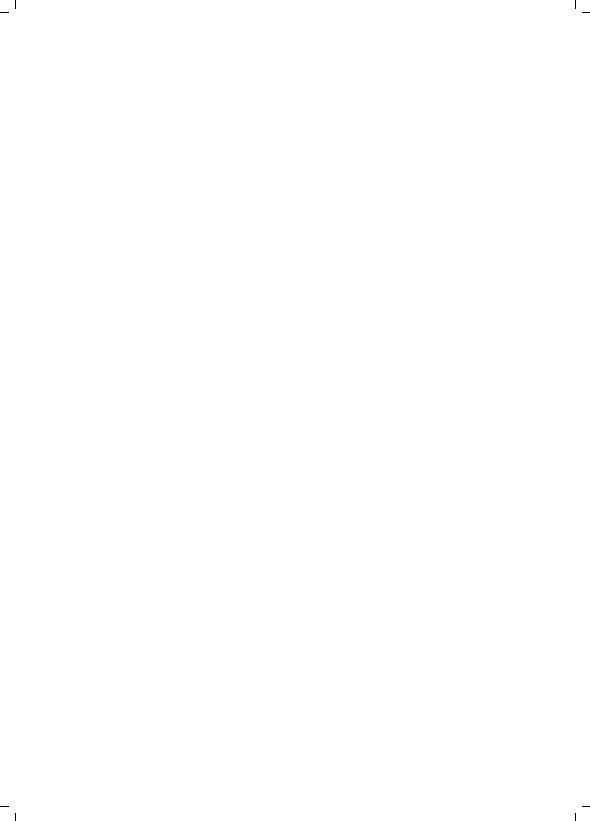
A-6 Foreword
–Repairs on the open road: collect the fluids, which have been drained (such as oil, fuel, coolant…).
–With an eye to environmental protection, take into consideration the laws in force (recovery of oil / anti-freeze / cartridges).
When draining oils (engine / gearbox / drive axles), you run the risk of burning yourself (hot oil).
When draining coolant, you run the risk of burning yourself (hot fluid).
–Independent heater: use motor vehicle diesel fuel only.
–If anti-skid chains are used, the rear wings should be removed, road speed should be reduced and chain tension should be tested at regular intervals.
Any modification to circuits (electrical, electronic or compressed air) may have serious consequences. Such work should only be undertaken in agreement with the manufacturer. RENAULT TRUCKS decline any responsibility in the event of non-conformity in assembly.
Only genuine, original RENAULT TRUCKS parts and circuits defined by the manufacturer guarantee quality, safety and reliability.
By observing the above instructions, you will be using your vehicle in the best possible way. However, you must also carefully read the driving handbook and consult the RENAULT TRUCKS network whenever you need any further information.
We remind you that application of the contractual warranty by RENAULT TRUCKS is subject, among other things, to proof by the customer that servicing and maintenance of the vehicle have been carried out according to our recommendations (frequency, operations to be performed, quality of expendable and consumable products guaranteed by genuine certified or recommended spare parts, quality and training of repair mechanics and use of specific tools…). Observance of these recommendations will also guarantee long-term reliability of the vehicle.
Servicing and maintenance conducted by the RENAULT TRUCKS network is a guarantee of observance of these recommendations. If the operations are conducted outside our network, the customer must provide formal proof that our recommendations have been observed.
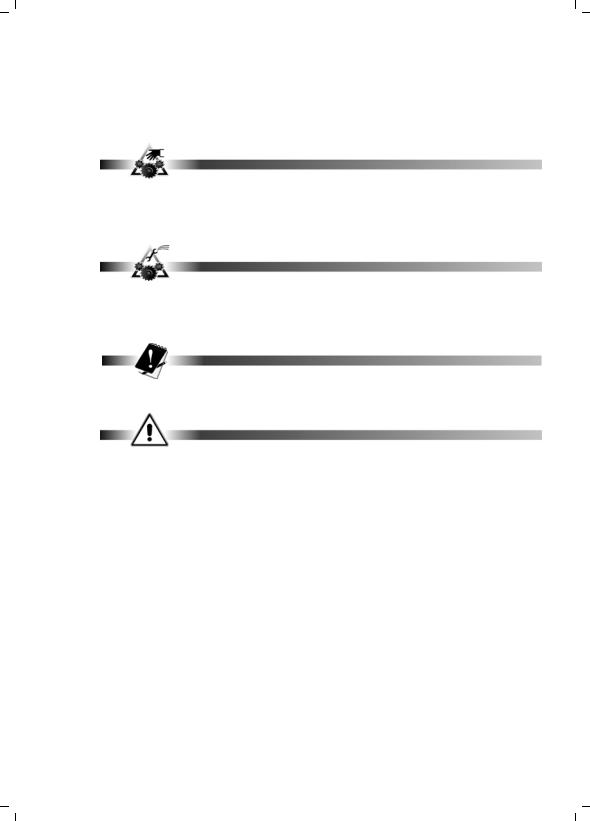
A-7 Foreword
Warnings
In this document, safety instructions are symbolized as follows:
DANGER! NON-OBSERVANCE OF THE PROCEDURE DESCRIBED OR LACK OF CARE OR ATTENTION RISK CAUSING SERIOUS INJURY OR EVEN DEATH.
WARNING! Any different or inappropriate working method risks causing damage to the product.
NOTE! Draws attention to particular or important points of the method.
Draws attention to special important points of procedures or regulations in force that must be obeyed without fail, especially those relative to the recovery and treatment of used parts and waste.
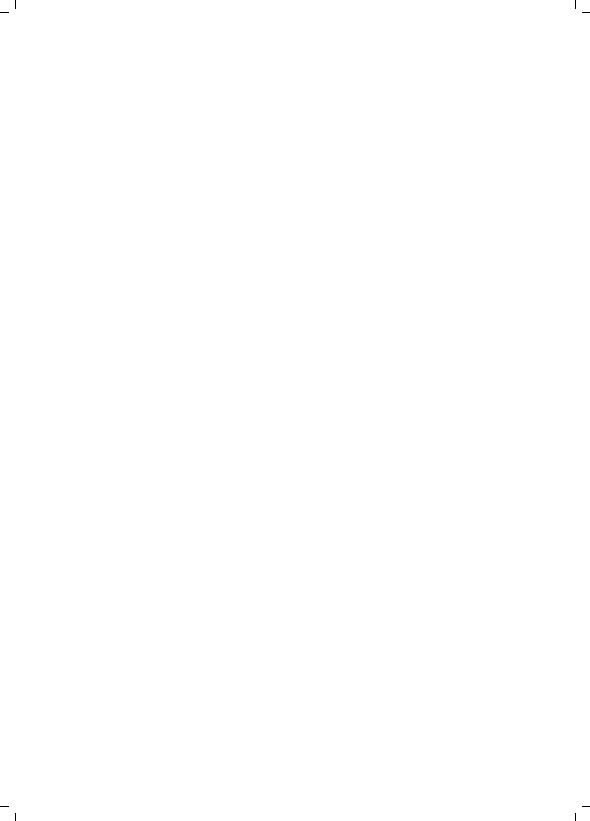
A-8 Foreword
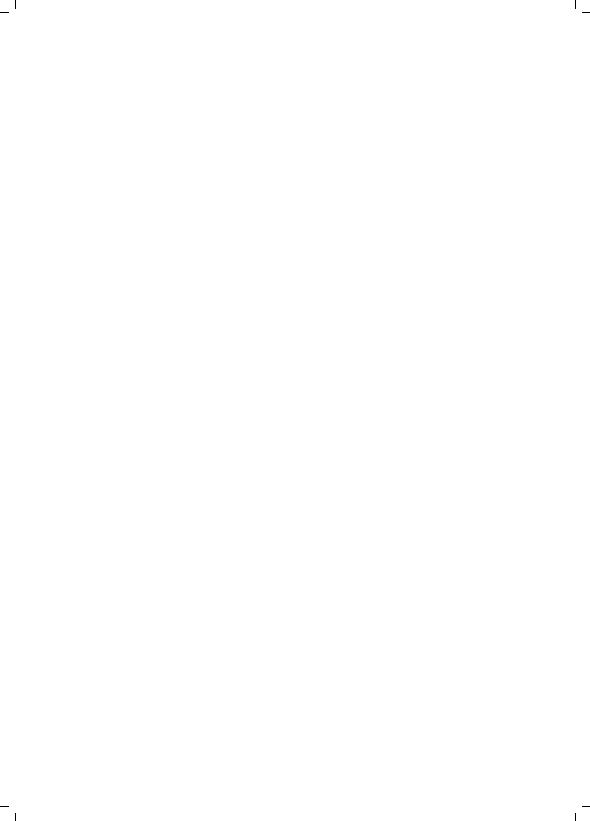
B1-1 Presentation
Vehicle access and protection
Keys
Depending on your vehicle’s equipment
Note down your key and remote control numbers here:
–Ignition:
–Doors:
–Remote control:

B1-2 Presentation
Doors
Opening from the outside
Unlock by inserting the key into lock (1). Tilt handle (2) upwards and pull the door.
Closing
Push the door until it engages automatically. Lock the door with the key in lock (1).
Opening of the door actuates the stepwell lighting and the overhead lights.
Opening from the inside Unlocking:
Tilt handle (3) upwards and push the door.
With the door open, handle (3) tilted downwards, the door unlocks automatically upon closing.
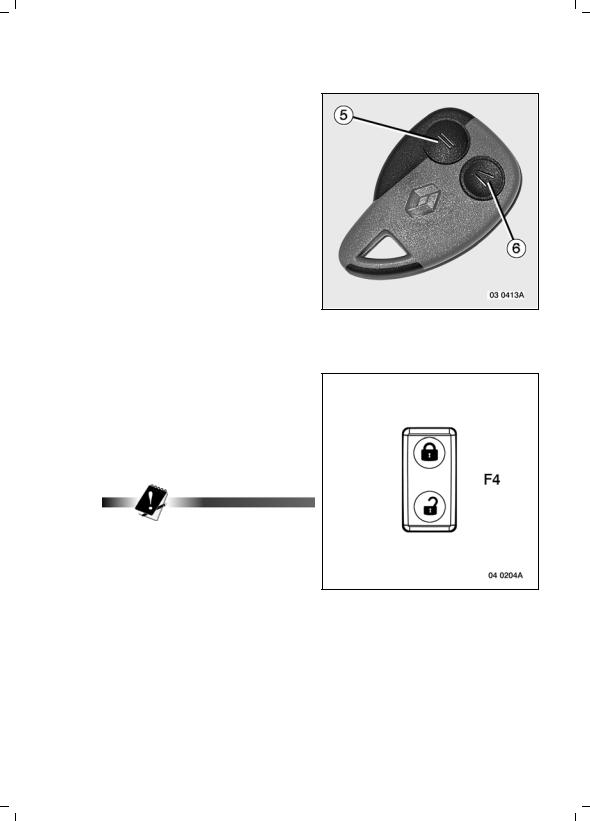
B1-3 Presentation
Closing:
Pull the door until it engages.
Locking:
With the door closed, tilt handle (3) downwards.
Central locking
Central locking from the inside:
Central locking is actuated:
–manually, by tilting handle (3) downwards,
–with the remote control, by pressing button (5),
–with dashboard switch (F4).
With the door open, handle (3) cannot be tilted downwards and the door unlocks automatically upon closing.

B1-4 Presentation
With the doors locked, prolonged pressing of switch (F4) in the locking position until the doors unlock, changes over from synchronized mode to de-synchronized mode and vice versa (pressing until unlocking).
Synchronized mode:
–Simultaneous opening of the doors by dabbing button (6) on the remote control.
–Simultaneous opening of the doors by turning the key in the driver’s or passenger’s side door lock.
Desynchronized mode:
–Opening of the driver’s door by dabbing button (6) on the remote control.
–Opening of the passenger’s door by dabbing a second time on button (6) on the remote control.
–Opening of the driver’s door by turning the key in the door lock once.
–Opening of the passenger’s door by turning the key in the door lock a second time in less than 3 seconds.
Simultaneous closing of the doors by dabbing button (5) on the remote control. Simultaneous closing of the doors by turning the key in the door lock a second time.
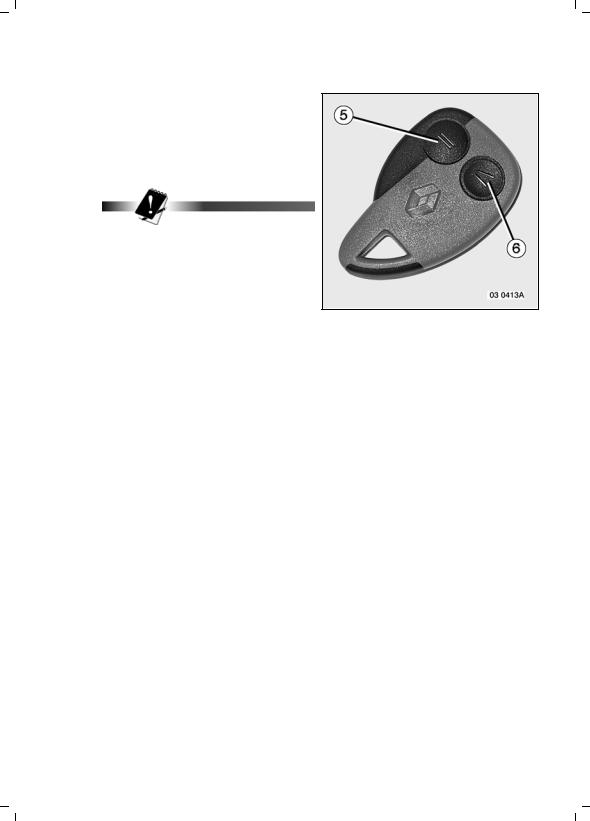
B1-5 Presentation
With the remote control
When you press locking button (5), the direction indicator warning light and the hazard lights warning light flash 4 times.
When you press unlocking button (6), the warning lights flash once.
Central locking is neutralized when the door is open.
Doors radio-frequency remote control
Depending on your vehicle’s equipment
This device does the same job as the door keys. All the doors are locked or unlocked without discrimination by keys or the remote control.
Use
The remote control is powered by a battery (CR 2032-3V) that should be replaced when the actuating range of the remote control becomes reduced.
Unlocking the doors and powering up the vehicle
Press button (6). This action, signalled by the flashing lights flashing, commands:
–powering up the vehicle (for vehicles equipped with an electrical master switch),
–disabling of the engine immobilizer,
–unlocking of the doors.
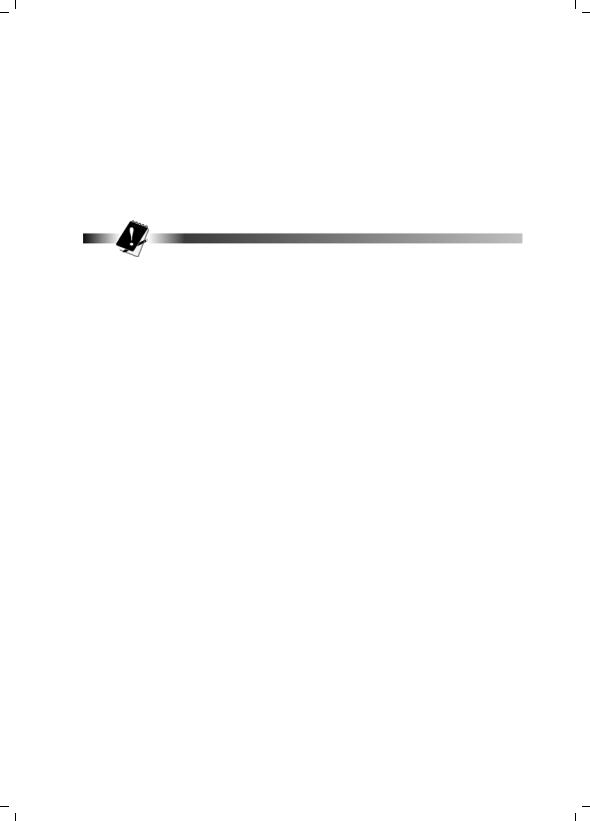
B1-6 Presentation
Locking of the doors only
Press button (5). This action, signalled by the flashing lights flashing 4 times, commands locking of the doors. The vehicle remains powered up with the engine immobilizer disabled.
Powering down the vehicle
A 2nd press on button (5) less than 10 minutes after the 1st press, signalled by a long flash lasting 1.5 seconds, causes:
–activation of the engine immobilizer,
–opening of the master switch for vehicles equipped with an electrical master switch.
If the flashing lights flash more than 4 times (e.g. after replacing the remote control battery), during the flashing phase, press one of the buttons 2 times to reactivate the remote control. If the flashing lights do not flash during the locking phase (in spite of the fact that they are working normally), it means that:
–at least one of the doors is not closed properly,
–there is a door locking actuator fault,
–there is a receiver fault.
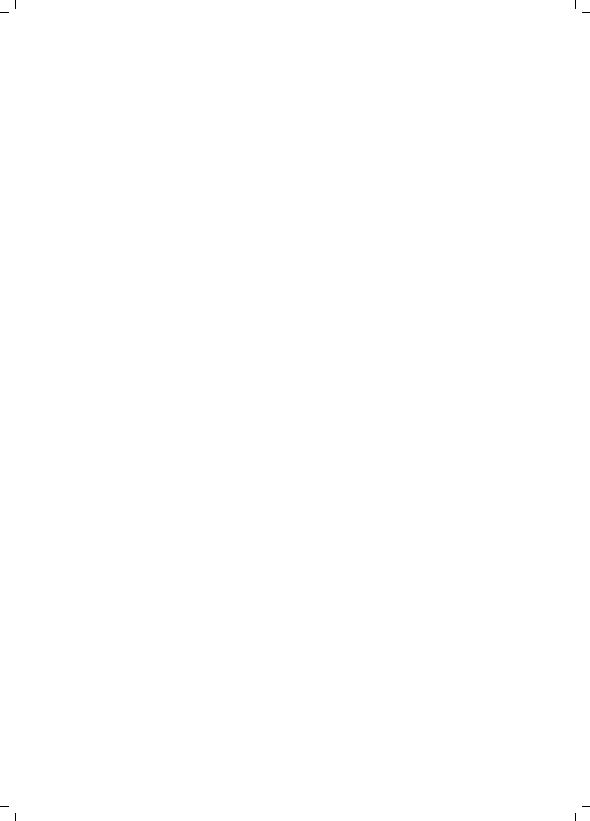
B1-7 Presentation
Interior and stepwell lighting
The vehicle is provided with 2 overhead lights, one above each of the doors, and 2 stepwell lights.
These lights come on and go out when the doors are opened and closed, when the vehicle is unlocked and locked and when the ignition key is in the «on» position prior to starting.
–When the doors are unlocked by the remote control, the interior lights comes on for a period of 17 seconds.
–When a door is opened, the interior lights stay on or come on again if they have gone out, for a period of 5 minutes (if at least one door remains open beyond that limit).
–After a door is closed, the interior lights stay on for 17 seconds, to give you time to put the key into the ignition switch.
–Switching on the ignition immediately causes the interior lights to go out.
–Stopping the engine causes the interior lights to come on for a period of 17 seconds.
–Locking of the doors causes the interior lights to immediately go out.
The overhead lights can be forced to come on by actuating one of the two switches.
See page(s) B2-74.
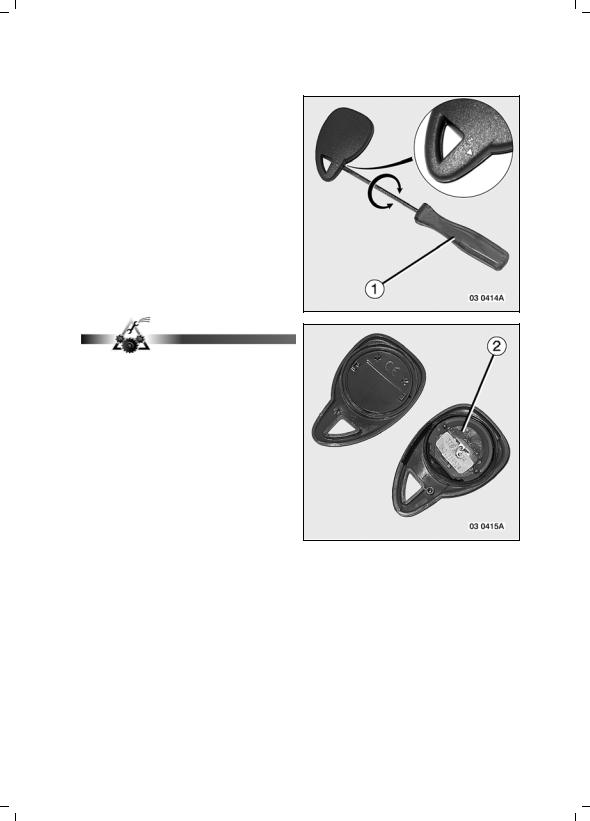
B1-8 Presentation
Replacing the battery
Using a screwdriver (1), open the casing in the place marked.
Replace battery (2) complying with the polarity engraved on the cover.
Use an alkaline type battery: CR 2032-3V. The battery service life is about 3 years.
Do not forget to make a note of the number of your keys. If you lose them or would like another set of keys or remote control, contact a RENAULT TRUCKS service point or dealer. Tell him the key numbers and show him the vehicle documents.
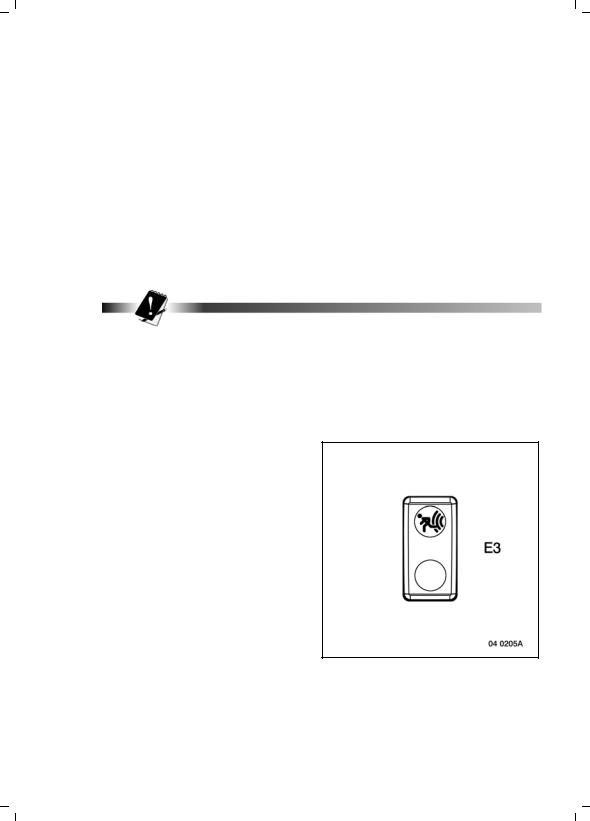
B1-9 Presentation
Alarm
Features
–«Panic» button in the event of aggression to the driver.
–Volumetric protection of the cab.
–Perimetric protection of cab doors.
–Cab tilting protection.
–«After ignition positive» protection.
–Protection against disconnection of batteries and disconnection of siren (self-powered siren).
–Alarm activation warning light on the control box.
–A pictogram and a message on the information display and a sound given off by the siren serve to identify the nature of the aggression.
The following features are only possible if the vehicle body and/or the coupled trailer is equipped with the freight protection box distributed by the RENAULT TRUCKS Boutique.
–Perimetric protection of vehicle body and/or trailer doors.
–Surveillance of onboard freight while at a standstill or when moving (opening of doors and unplugging of trailer electrical socket).
«Panic» button
In the event of aggression, press «panic» button (E3) for about 2 seconds to give the alert. The siren sounds immediately and the hazard lights flash. To stop the siren and the hazard lights, press button (E3) again for about 2 seconds.
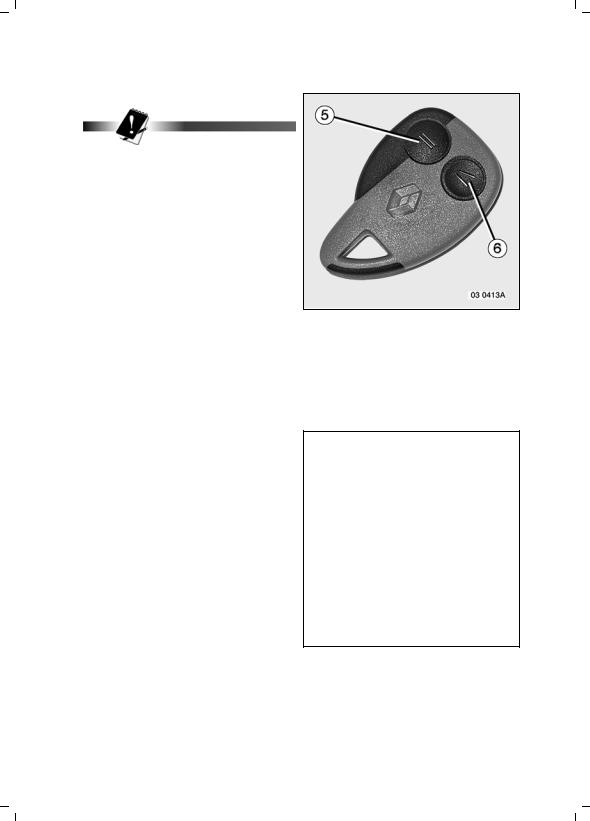
B1-10 Presentation
Activation of the alarm
The alarm is activated and disabled by means of the radio frequency remote control. If the vehicle body and/or trailer are equipped with the freight protection box, it will be automatically taken into account by the central alarm box.
Vehicle powered up (master switch closed): press the remote control button (5):
–The cab doors lock.
–The hazard lights flash 4 times.
–The red LED (4) on the control box (3) flashes — the alarm is activated 10 seconds later.
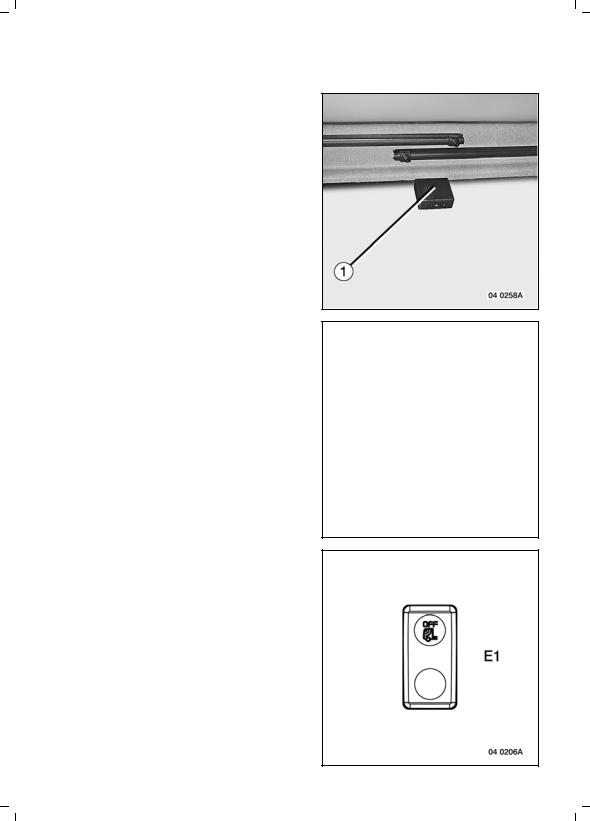
B1-11 Presentation
Control box position (1)
Activation of the alarm without volumetric protection and without cab tilting protection
Vehicle powered up (master switch closed): Two methods are proposed:
Ignition key in steering lock position (1) or
(2).
The «volumetric alarm exclusion arm» warning light (E1) is on.

B1-12 Presentation
Press button (5) on the remote control:
–The cab doors lock.
–The warning light on the «volumetric alarm exclusion» switch (E1) goes out,
–The hazard lights flash 4 times.
–The red LED (4) on the control box (3) flashes — the alarm is activated 10 seconds later.

B1-13 Presentation
Ignition key in your possession
–Take the key out of the ignition switch.
–Press «volumetric alarm exclusion» switch (E1), warning light comes on.
–Press button (5) on the remote control:
•The warning light on the «volumetric alarm exclusion» switch (E1) goes out.
•The cab doors lock.
•The hazard lights flash 4 times.
–The red LED (4) on the control box (3) flashes — the alarm is activated 10 seconds later.
When your vehicle is being transported by boat or rail convoy, activate the alarm without volumetric protection and without cab tilting protection to avoid any inadvertent triggering of the alarm.

B1-14 Presentation
Fall-back mode
During the 10 seconds necessary to activate the alarm, all the alarm sensors are checked out. If a door has been left open, the siren sounds to draw attention to the problem. After these 10 seconds, the door in question will be excluded and not protected. The fall-back mode can be used while freight is being unloaded.
If the door in question is closed after the alarm is activated, it will be locked and protected.

B1-15 Presentation
Disabling of the alarm
With the vehicle powered up, press button (6) on the remote control:
–The vehicle is powered up (only for vehicles equipped with an electrical master switch).
–The cab doors unlock.
–The red LED (4) on the control box (3) goes out.
In the event of remote control malfunction, you can disable the alarm by turning the ignition key to the «ignition» position (3). After that, it is necessary to re-synchronize the remote control with the alarm by activating and de-activating the system once more.
If there is an attempt at theft of the vehicle or its freight, the siren sounds after the alarm has been disabled. It is possible to find out what kind of intrusion has been perpetuated by means of the message and the pictogram (G36) shown on the information display.
The message and the pictogram are erased when the ignition is switched on, with the ignition key in position (3).

B1-16 Presentation
«Starting impossible»
In the event of transponder malfunction, it is impossible to start the engine. The message «Starting impossible» is shown on the information display. Call upon the nearest RENAULT TRUCKS service point or dealer.
Stopping of the alarm without opening the door(s)
If the doors are unlocked and the alarm stops without the doors being opened within a period of 2 minutes, the doors are locked and the alarm is re-activated automatically.

B1-17 Presentation
Front grille
Pull the bottom part of the radiator grille to open it. Push it to close.
WHEN WORKING AT THE FRONT END OF THE VEHICLE WITH THE FRONT GRILLE OPEN, ENSURE THAT THE WINDSCREEN WIPER SWITCH IS IN THE «OFF» POSITION. IT MIGHT PROVE TO BE DANGEROUS IF YOU PLACE YOUR HANDS ON THE SCREEN WIPER LINKAGE. IF POSSIBLE, DISENGAGE THE MASTER SWITCH.

B1-18 Presentation
Side fairings
Opening
Unlock side fairings (1):
Lift up catches (2), pivot them through 1/4 of a turn, then pull the fairings until they are held by straps (3).

B1-19 Presentation
It is possible to remove the fairings completely by unhooking the holding straps (3) and pulling the fairings towards yourself to dislodge them from the rubber sandwich mountings (4).
Closing
If the fairings have been removed , fit them into the rubber sandwich mountings (4) by pushing them at the bottom and fasten the strap snap hooks (3).
Push the side fairings (1), pivot the catches (2) through 1/4 of a turn.
Ensure that the fairings are correctly locked.

B1-20 Presentation
Cab tilting
NEVER TILT THE CAB WHILE THE ENGINE IS RUNNING.
Before restarting the engine, check:
–Cab raised: that the gear lever is in neutral.
–Cab lowered: that the gearshift linkage is locked, after checking that all gears shift correctly.
When working underneath the cab (on the engine, etc…), the cab must be fully tilted. Any work on the cab tilt hydraulic system requires strict observance of the safety instructions and should therefore be carried out by a RENAULT TRUCKS service point or dealer.
Cab tilting hydraulic system Filling and checking oil level
With the cab in the «road» position, fill with oil through oil reservoir filler port (2).
To gain access to the oil reservoir,, slacken screw (1) and pivot the headlamp insert. Check the oil level: the oil should be flush with the top of piston (3) when it is in the «down» position.
Carefully carry out one complete tilting manoeuvre (up and down), then check the oil level again. In the event of malfunction, consult a RENAULT TRUCKS service point or dealer.

B1-21 Presentation
Depending on your vehicle’s equipment
Before tilting the cab:
–Lock the storage compartments.
–Empty the bottle-holder.
–Stop the refrigerator.
Depending on your vehicle’s equipment
Mechanical control
With the vehicle stationary, engine shut down, gear lever in neutral, doors properly closed, make sure that no loose articles in the cab can be thrown against the windscreen. Clear the area in front of the cab. Place lever (1) in the «up» position. Use operating bar (2).
Since unlocking is automatic, pump until the cab tilts fully. Use jack handle (3) to add leverage to the operating bar (2). Force the operating bar fully downwards.
To return the cab to the «road» position, place lever (1) n the «down» position, pump until the cab locks automatically.
If you experience difficulty in tilting, return the cab to the «road» position and check the oil level. Top up with oil, if necessary.
Carefully carry out one complete tilting manoeuvre (up and down), then check the oil level again. In the event of malfunction, consult a RENAULT TRUCKS service point or dealer.
It is impossible to open the front grille when the cab is tilted.

B1-22 Presentation
Depending on your vehicle’s equipment
Electrical control
Depending on the assembly, the mechanical control is assisted by an electrical control. Place lever (1) in the «up» position. Use operating bar (2).
With the ignition switched on, press button (4). Since unlocking is automatic, pump until the cab tilts fully.
To return the cab to the «road» position, place lever (1) in the «down» position, press button
(4) until the cab locks automatically. Do not leave your hands on the step during the manoeuvre.
After 2 successive tilting manoeuvres (up and down), wait for 15 minutes for the pump motor to cool down before starting again.
If you experience difficulty in tilting, return the cab to the «road» position and check the oil level.
In the event of electrical failure (control or pump), use the mechanical cab tilt control.

B1-23 Presentation
External storage locker(s)
Depending on your vehicle’s equipment
Opening and closing of compartment (1) with handle (2). Locking with key lock.
Opening and closing of compartment (1) with handle (2). Locking with key lock.

B1-24 Presentation
Opening: Pull control (1) to unlock the door. Lift up door (2). There is a strut to hold the door open.
A light fitted with a switch comes on when the master switch is engaged.
Closing: Push control: (1) free the strut and close door (2). Locking is automatic.
The tool locker under the cab is not provided with a strut. It is held open by a hard spot that has to be overcome when closing.

B1-25 Presentation
Fuel tank(s)
Fuel filler cap
The filler cap is locked by a key lock (1).
Vehicle equipped with two fuel tanks without changeover valve
Since there is no fuel gauge switch, the fuel level gauge shows the total contents of both fuel tanks.
When filling up with fuel, you are recommended to put fuel into both tanks.
Depending on your vehicle’s equipment
SWITCH OFF THE INDEPENDENT HEATER BEFORE YOU FILL THE FUEL TANK(S).

B1-26 Presentation
Master switch
Depending on your vehicle’s equipment
Turn handle (1) through one quarter of a turn to isolate the electrical installation except for alarm, central door locking, tachograph, independent heating timer and hazard lights.
If the vehicle is equipped with a remote control for electrically locking the doors coupled with the master switch control, refer to page B-1-5 on how to use it.

B1-27 Presentation
«ADR» master switch (transport of dangerous materials)
Use of the ADR battery isolating switch
Several parameters are involved:
–ignition key inserted in ignition switch,
–chassis exterior switch,
–cab interior switch,
–following electrical consumers:
•side/parking lights,
•hazard lights,
•suspension,
•independent heating.
Operation
Cab interior switch (B4)
Chassis exterior switch (2)
Switch type operation
The battery isolating switch can be operated by means of switch (B4) or (2).
If either of the two switches is actuated, it is essential for the key to be put back into the ignition switch and for the those switches to be in the «ON» position to close the battery isolating switch.
The «ADR» battery isolating switch serves to supply electrical power to the vehicle if neither of the two switches is actuated by the driver.
If either of the two switches is actuated, the «ADR» battery isolating switch cuts the electrical power supply to the vehicle and the engine stops automatically.

B1-28 Presentation
Operation by insertion of ignition key in ignition switch
With the «ADR» battery isolating switch in the position for supplying electrical power to the vehicle (switches (B4) — (1) not actuated and ignition key inserted in ignition switch): if the driver takes the ignition key out of the ignition switch and if none of the electrical consumers quoted earlier is in operation, the «ADR» battery isolating switch cuts the electrical power supply to the vehicle after a period of 20 minutes.
The electrical power supply will be restored to the vehicle when the ignition key is inserted into the ignition switch. If the driver’s door is locked by the door key, unlock it with that key.
Vehicle equipped with independent heating
(See page B2-66).

B2-1 Presentation
Driving position
Seats
For your own safety, it is essential to remove the plastic protective cover when putting the vehicle into commission.
Seat suspension
Adjust the flexibility of the suspension according to the state of the road and the user’s weight.
Air-operated seats
Controls will only work if there is sufficient air pressure.
Driver’s seat
Passenger(s) seat
Depending on your vehicle’s equipment
Depending on seat use (i.e. driver, passenger, left or right hand drive), controls are located to one side or the other. The seat type shown is just one possible solution.
1 — «Vertical» Ssuspension «vertical» flexibility adjustment:
–Upwards: hard suspension.
–Downwards: supple suspension. 2 — Fast suspension lowering.
3 — «Lower» lumbar support adjustment control.
4 — «Upper» lumbar support adjustment control.
5 — Side support adjustment.
6 — Heated seat cushion and squab (automatic thermostat-regulated operation).
FOR SAFETY REASONS, ALL SEAT ADJUSTMENT OPERATIONS MUST BE CARRIED OUT WHEN THE VEHICLE IS AT A STANDSTILL.
WHEN THE VEHICLE IS MOVING, ANY USE OF THE SEATS IN A POSITION OTHER THAN THAT OF «FACING THE ROAD» INVOLVES THE RESPONSIBILITY OF THE USERS.

B2-2 Presentation

B2-3 Presentation

B2-4 Presentation

B2-5 Presentation

B2-6 Presentation
Dashboard

B2-7 Presentation

B2-8 Presentation
Depending on your vehicle’s equipment
1— Switches (see page B2-24)
2— Air vent(s) control
3— Air vent
4— Information display
5— Thermal comfort panel
6— Ledge with non-slip surface (to be used only when the vehicle is stationary).
7— Fuses
8— Storage spaces
9— Electrical socket 24V (360W maxi)
10— Storage drawer / modular space
11— Electrical socket 12V (120W maxi)
12— Modular space (radio)
13— Cigar lighter
14— Steering wheel adjuster
15— Diagnostic socket
15— Infomax socket
16— Switches / modular space
17— Modular space (tachograph)
18— Parking brake control
19— Air blower outlet
20— Static trailer brake
21— Trailer brake

Some RENAULT Premium Truck Service Manual & Wiring Diagrams PDF above the page.
The Renault Premium truck was produced from 1996 to 2013. The machine was used both as a main tractor, and a city van, and
as a chassis for special equipment.
Specialists share Premium on dCi (first generation) and dXi (new gamut).
The dCi designation is due to a common rail engine with electronic V-MAC control. This system analyzes various truck operating parameters and calculates the
optimum injection timing.
This improves fuel combustion, improves engine performance and reduces fuel consumption.
By the way, according to this criterion, Premium is one of the best representatives of heavy-duty commercial vehicles. In addition, the V-MAC monitors and
regulates the braking process, controls the engine brake and retarder in the transmission.
The truck’s system also includes cruise control, which ensures optimal driving in the selected mode.
 |
|||
|
|











